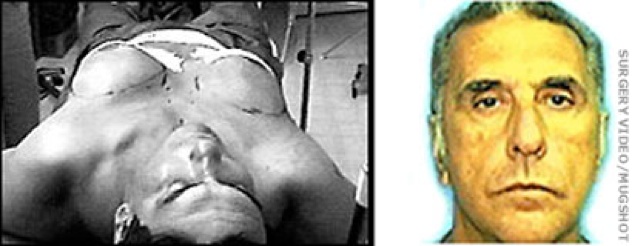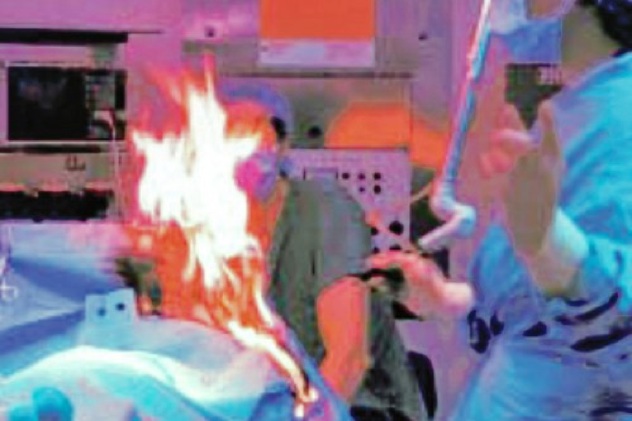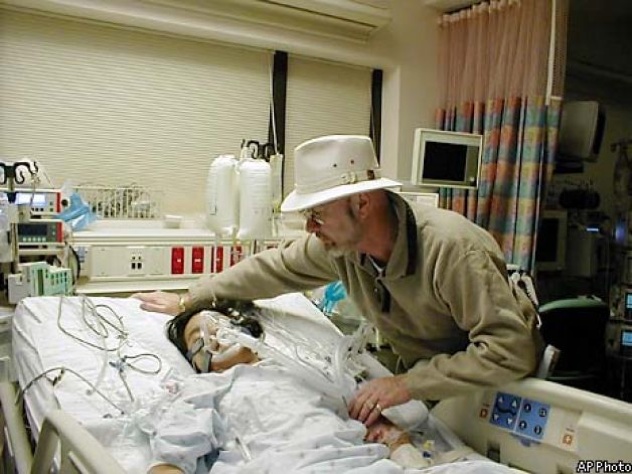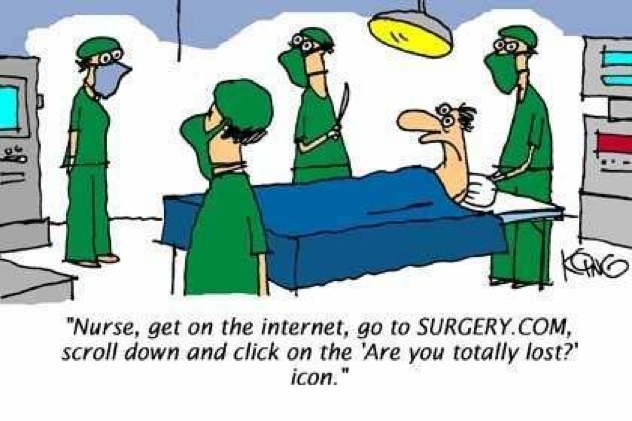 Technology
Technology  Technology
Technology  Humans
Humans 10 Everyday Human Behaviors That Are Actually Survival Instincts
 Animals
Animals 10 Animals That Humiliated and Harmed Historical Leaders
 History
History 10 Most Influential Protests in Modern History
 Creepy
Creepy 10 More Representations of Death from Myth, Legend, and Folktale
 Technology
Technology 10 Scientific Breakthroughs of 2025 That’ll Change Everything
 Our World
Our World 10 Ways Icelandic Culture Makes Other Countries Look Boring
 Misconceptions
Misconceptions 10 Common Misconceptions About the Victorian Era
 Mysteries
Mysteries 10 Strange Unexplained Mysteries of 2025
 Miscellaneous
Miscellaneous 10 of History’s Most Bell-Ringing Finishing Moves
 Technology
Technology Top 10 Everyday Tech Buzzwords That Hide a Darker Past
 Humans
Humans 10 Everyday Human Behaviors That Are Actually Survival Instincts
 Animals
Animals 10 Animals That Humiliated and Harmed Historical Leaders
Who's Behind Listverse?

Jamie Frater
Head Editor
Jamie founded Listverse due to an insatiable desire to share fascinating, obscure, and bizarre facts. He has been a guest speaker on numerous national radio and television stations and is a five time published author.
More About Us History
History 10 Most Influential Protests in Modern History
 Creepy
Creepy 10 More Representations of Death from Myth, Legend, and Folktale
 Technology
Technology 10 Scientific Breakthroughs of 2025 That’ll Change Everything
 Our World
Our World 10 Ways Icelandic Culture Makes Other Countries Look Boring
 Misconceptions
Misconceptions 10 Common Misconceptions About the Victorian Era
 Mysteries
Mysteries 10 Strange Unexplained Mysteries of 2025
 Miscellaneous
Miscellaneous 10 of History’s Most Bell-Ringing Finishing Moves
10 Horrible Cases Of Medical Malpractice
Doctors have often been seen as some of the smartest members of society, and with good reason. It takes years of training, constant retraining, and a lot more than just book smarts to be a good doctor. But they are still human, and humans are fallible. Mistakes are made every day, and while some of them can be insignificant, others can completely change lives. Suing doctors for less-than-perfect practice is becoming more and more common, the morality of which is debatable. If you need help, and only certain people are able (and often, legally obliged) to help you, is it really fair to blame them if their best isn’t good enough? In many cases on the other hand, it is clear if a patient suffered because somebody was careless. Below are ten examples of some of the most cringe-inducing medical malpractices of recent years.

Going in for brain surgery is worrying enough for most patients, but those in Rhode Island Hospital could be forgiven for being more worried than most. Despite being the most prestigious hospital of the state, and a teaching hospital for students of Brown University, the hospital made the basic yet tremendous mistake of operating on the wrong side of a patient’s brain. Three times in one year.
The first incident was the result of a third-year resident failing to mark which side of the brain was to be operated on. The doctor and nurse in this operation claimed they were not trained in how to use a checklist, although one must ask how many people would allow their heads to be cut open by someone who has clearly never received professional training in the fine art of grocery shopping.
In the second incident, a different doctor (with over 20 years experience) never filled out which side of an 86 year old man’s brain had a blood clot, assuring the nurse that he remembered. The patient in this case died a few weeks later.
In the third case, the chief resident neurosurgeon and a nurse both clarified which side of the brain was to be operated on beforehand, and then proceeded to operate on the other side. All three cases involved different doctors, but whether it’s better to be in a hospital where one doctor repeats a mistake multiple times, or several doctors make the same mistake is debatable.

Alexander Baez is a former Mr. Mexico and a runner-up Mr. Universe. Being a bodybuilder, he is, unsurprisingly, concerned with his physique, and in 1999 he decided he wanted to get pec implants. When he awoke from his surgery, he discovered that while he had been given implants, he was actually given breast implants (C-cups), and not pec implants. Police in Florida began a search for Reinaldo Silvestre, a man who had posed as a doctor and had no legitimate medical credentials. Silvestre had forged documents and had also operated on at least two women in Florida, using kitchen utensils. In 2004, Silvestre was found in working in Belize, where he is believed to have treated hundreds of patients over at least a one year period.

Carol Weihrer had long suffered pain in her right eye, and at the advice of her doctor, decided her quality of life would be improved if she had the eye removed. The surgery was five and a half hours long, and for about two of those hours, Carol was awake. She explained that anesthesia is made up of two different elements, one to paralyze the patient, and one to put them to sleep. Unfortunately, only the paralyzing agent worked fully in her case, and halfway through the operation, she woke up but could not move at all. She was horrified to hear the surgeon listening to disco music throughout, as well as having to hear things like “Cut deeper, pull harder”. Carol was awake for the exact moment they removed the eye. Eventually, the doctor realized she was conscious, and the administered more of the nerve-blocking anesthesia, which Carol described made her insides feel like “being roasted on a barbecue pit”. She was so traumatized by the ordeal that she has slept in a reclining chair since, too afraid to lie down. Cases like these are known as Anesthesia Awareness, and it is estimated that up to 42,000 people in the US alone experience it every year.

Never having been in for any sort of surgery in my life (and after writing this, hoping I never will be), I can only imagine the worries people have beforehand: how skilled is the surgeon, what if they cut something they shouldn’t and so on. I also think it’s safe to assume that “What if I catch on fire?” isn’t a common concern among patients. But perhaps it should be. In 2009 Janice McCall, 65, died six days after she caught fire during surgery. While the cause of the fire was not released in this case, there are a number of other examples to that can explain possible causes to igniting in surgery: In 2012, Enrique Ruiz suffered second-degree burns after an electronic scalpel caused his oxygen supply to explode, which the hospital then tried to cover up.
In another case, Catherine Reuter, 74, suffered second and third-degree burns after a cauterizing tool caused the alcohol based disinfectant on her face to catch fire. The incident led to strong infections, kidney failure, and long-term sedation. Reuter never fully recovered, and died in hospital two years later. It is estimated that surgical fires affect up to 650 patients a year.

It’s likely that everyone reading this will have heard stories about people who get operations and later find out that they had foreign objects stitched inside them. There are about 1,500 such reports every year in the US. While uncommon, such an occurrence can be extremely painful, and can lead to other complications such as infection or internal bleeding. What sets Daryoush Mazarei out from other examples is not the fact that the item left behind inside his chest, a retractor, was 10 inches long, nor that it could physically be seen poking out. It is that when he went back to the University of Pittsburgh Medical Centre, he was told he should seek psychiatric care. After a month of agonizing pain, multiple complaints, and repeatedly being told the problem was in his head, Marazei was finally given a CT scan, and the item was removed. He has begun legal proceedings against the hospital.

Jesica Santillan was a 17 year old girl who died 15 days after receiving a heart and double-lung transplant. Undoubtedly, this was a major operation and any number of things could have gone wrong. The whole thing could have even gone perfectly, but failed if Jesica’s body rejected the new organs. While her body did reject the organs, it was not simply a case of bad luck. With such long waiting lists for organs in the US, you would think that the professionals in Duke University Hospital would make sure that the organs they intend to transplant are the same blood type as the person they’re going into. Unfortunately, Jesica was blood type O, and received organs from someone that was blood type A, something over a dozen people were supposed to check, but didn’t. The hospital hid the mistake for 11 days, and then went public looking for another donor. She received a second transplant two weeks after the first one, but was declared brain dead and taken off life support. Her mother believes that she was weaned off her medication so she would seemingly pass away naturally.

Only people who have actually seen it for themselves can really know how easy it is to look at something like a pair of kidneys and tell which one is healthy and which is not. Apparently, it’s not as clear a difference as you might think. In 2000, 70 year old Graham Reeves of Wales died after not one, but two surgeons removed the wrong kidney. This sort of error is not an isolated incident, nor is it confined to any one body part. Benjamin Houghton, an Air Force veteran, received $200,000 compensation after doctors removed the wrong testicle, while Willie King, who suffered from diabetes, received a total of $1.15 million after his right leg was amputated by mistake (with the correct leg being amputated later).

Kim Tutt was getting her jaw x-rayed at the dentist, when they noticed a large lump on the left side of her jaw. After undergoing further examinations, she was told she had 3-6 months to live. The doctors told her she could possibly get an extra three months if they removed the left side of her chin, right up to her ear, and replaced it with her fibula. Desperate to spend more time with her 10 and 12 year old sons, she underwent the procedure. The lump was removed, and although slightly disfigured, Tutt was grateful to have extra time with her sons. Three months later, she was called to the doctors office, who gave her the good news that she was cancer free. The bad news was that she had in fact never had cancer at all. There had been a mix up in the lab, and Kim Tutt had gone through five surgeries and been left disfigured for nothing.

Medical malpractice is not limited to surgery, and the case of Paul Lozano illustrates this better than any other example. Lozano had been sexually abused by his mother as a child, and his psychiatrist, Margaret Bean-Bayog, decided to try a form of therapy known as “reparenting”, where the psychiatrist simulates the different stages of lifespan development in an attempt to “reprogram” the patient. She coddled him, read him stories, called him “baby”, made him call her “mother”, and made him learn cue-cards off by heart. One such card read “I’m your mom and I love you and you love me very much. Say that 10 times”. Other cards were more sexual, and more notes were found that appeared to be erotica featuring Lozano and his doctor. It was also reported that they did in fact have sexual relations. After about five years, he committed suicide.

Some of the examples mentioned so far were a result of poor communication, while others can be attributed to bad practice. Depending on who and what you believe, it can be argued that both of these are present in the case of Bryan Mejia, but what sets it apart from the others is the ethical debate that it sparked. Bryan was born with only one leg, and no arms. The deformity is obviously not the fault of the medical staff at Palm Beaches, but parents Ana Mejia and Rodolfo Santana have accused the staff of negligence for not properly detecting this through ultrasounds, saying they would have aborted their son if they had known he would only have one limb. Most people would expect that a doctor would be able to alert the parents-to-be of such a disability, but Dr. Morel, the defendant, argued that he is not to blame. The couple, who feared the child may be born with down-syndrome, opted not to undergo amniocentesis after they were told there was a 99.9% chance that the child would not have any form of mental disability. This test would have detected the missing limbs, but there was a 1 in 500 chance that it could result in a miscarriage, and Morel argued that it was their decision, and he cannot be blamed. But according to the lawyer representing the couple, the second ultrasound given to them shows all four limbs intact, suggesting they were given false evidence.
The couple was awarded $4.5 million, to help Bryan have a good life, and stated that none of this was compensation for their mental anguish. But many people see this as the couple suing the hospital because they had a disabled child. This, the fact that the couple say they would have aborted their son, and the accusations of malpractice, all caused widespread outrage and debate.








